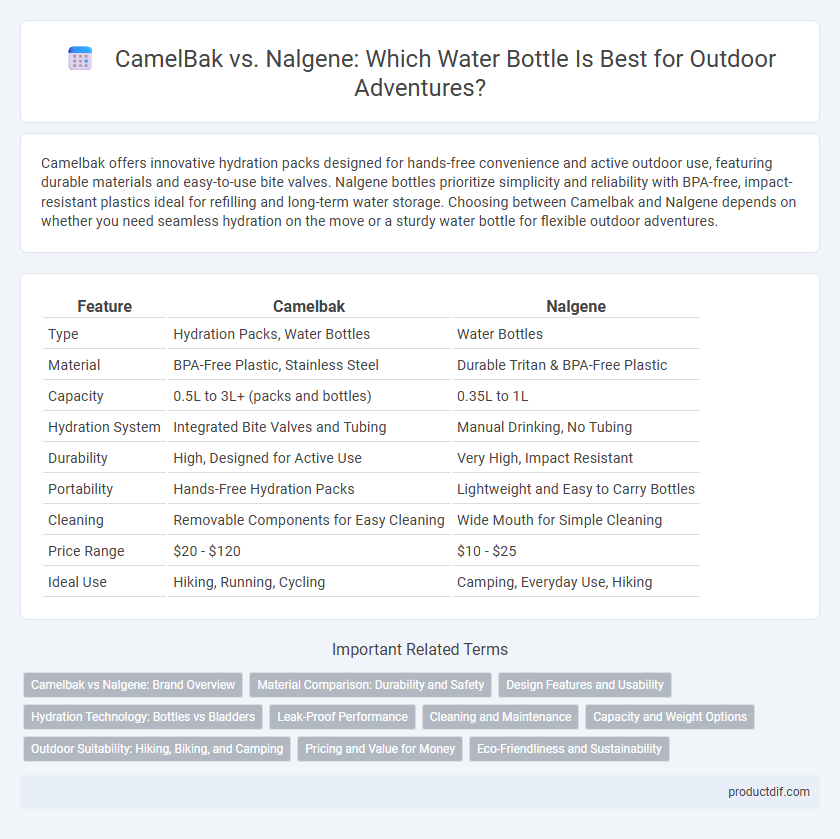Camelbak offers innovative hydration packs designed for hands-free convenience and active outdoor use, featuring durable materials and easy-to-use bite valves. Nalgene bottles prioritize simplicity and reliability with BPA-free, impact-resistant plastics ideal for refilling and long-term water storage. Choosing between Camelbak and Nalgene depends on whether you need seamless hydration on the move or a sturdy water bottle for flexible outdoor adventures.
Table of Comparison
| Feature | Camelbak | Nalgene |
|---|---|---|
| Type | Hydration Packs, Water Bottles | Water Bottles |
| Material | BPA-Free Plastic, Stainless Steel | Durable Tritan & BPA-Free Plastic |
| Capacity | 0.5L to 3L+ (packs and bottles) | 0.35L to 1L |
| Hydration System | Integrated Bite Valves and Tubing | Manual Drinking, No Tubing |
| Durability | High, Designed for Active Use | Very High, Impact Resistant |
| Portability | Hands-Free Hydration Packs | Lightweight and Easy to Carry Bottles |
| Cleaning | Removable Components for Easy Cleaning | Wide Mouth for Simple Cleaning |
| Price Range | $20 - $120 | $10 - $25 |
| Ideal Use | Hiking, Running, Cycling | Camping, Everyday Use, Hiking |
Camelbak vs Nalgene: Brand Overview
Camelbak is renowned for its innovative hydration solutions, particularly its hands-free water bladders and durable, lightweight backpacks designed for outdoor adventures. Nalgene specializes in high-quality, BPA-free plastic water bottles that are favored for their durability, wide mouth openings, and versatile use in hiking, camping, and everyday hydration. Both brands emphasize durability and functionality, with Camelbak excelling in integrated hydration systems and Nalgene in classic, rugged bottle designs.
Material Comparison: Durability and Safety
Camelbak bottles feature Tritan or stainless steel construction, offering high durability and BPA-free safety for long-term use in rugged outdoor conditions. Nalgene bottles are made from BPA-free Tritan plastic or LDPE, known for impact resistance and lightweight durability, making them ideal for everyday outdoor activities. Both brands prioritize safety with toxin-free materials, but Camelbak's stainless steel options provide enhanced durability and insulation for extreme environments.
Design Features and Usability
Camelbak water bottles feature ergonomic designs with integrated bite valves and spill-proof mechanisms, enhancing on-the-go usability for outdoor activities. Nalgene bottles are renowned for their wide mouths, durable BPA-free materials, and compatibility with various lids, offering versatility and ease of cleaning. Both brands prioritize durability, but Camelbak emphasizes user-friendly hydration systems while Nalgene focuses on rugged simplicity and multi-purpose functionality.
Hydration Technology: Bottles vs Bladders
Camelbak excels in hydration technology by offering versatile bladders with hands-free sipping and high-capacity storage ideal for long hikes and cycling. Nalgene specializes in durable, BPA-free water bottles known for their wide mouths, leak-proof designs, and chemical resistance, making them perfect for everyday use and outdoor adventures. Choosing between Camelbak's hydration reservoirs and Nalgene's rigid bottles depends on preferences for ease of use, cleaning convenience, and activity type.
Leak-Proof Performance
Camelbak water bottles feature advanced leak-proof designs with secure bite valves and press-to-drink mechanisms, making them ideal for active outdoor use and minimizing spills. Nalgene bottles utilize robust, screw-on caps with wide-mouth openings that offer reliable leak prevention, though they may be less convenient for quick sips during rigorous activities. Both brands emphasize durable construction, but Camelbak excels in leak-proof performance for dynamic outdoor adventures.
Cleaning and Maintenance
Camelbak water bottles feature wide mouths and detachable parts, making them easier to clean thoroughly and prevent mold buildup. Nalgene bottles have simple, durable designs with wide openings that allow easy hand washing and are dishwasher-safe, enhancing maintenance convenience. Both brands prioritize hygienic use, but Camelbak's bite valve components require more detailed cleaning compared to Nalgene's straightforward design.
Capacity and Weight Options
Camelbak offers a range of outdoor hydration packs and bottles with varying capacities from 0.5 liters to 3 liters, emphasizing lightweight, ergonomic designs suited for active use. Nalgene is known for its durable, BPA-free water bottles, typically available in sizes from 0.5 liters up to 1 liter, with heavier weight due to robust plastic construction. While Camelbak prioritizes portable hydration solutions with multiple weight options for different activities, Nalgene focuses on sturdy, straightforward water storage with fewer size variations.
Outdoor Suitability: Hiking, Biking, and Camping
Camelbak hydration packs offer hands-free water access and insulated reservoirs ideal for hiking, biking, and camping, enhancing convenience and hydration efficiency. Nalgene bottles provide durable, BPA-free plastic construction with wide mouths for easy cleaning and filling, suited for rugged outdoor conditions but requiring manual drinking. For intense activities involving continuous hydration, Camelbak outperforms, while Nalgene excels in versatility and ease of maintenance during extended outdoor excursions.
Pricing and Value for Money
Camelbak offers hydration packs and water bottles typically priced higher due to advanced features like insulated designs and integrated filtration systems. Nalgene water bottles are more affordable, known for durability and simplicity, making them a budget-friendly choice for outdoor enthusiasts. While Camelbak provides enhanced functionality, Nalgene delivers excellent value for money with long-lasting, basic hydration solutions.
Eco-Friendliness and Sustainability
Camelbak and Nalgene differ notably in eco-friendliness and sustainability, with Camelbak emphasizing BPA-free materials and offering refillable hydration packs made from recycled content. Nalgene also uses BPA-free plastics but stands out with its durable, long-lasting bottles designed to reduce single-use plastic waste over time. Both brands promote reducing environmental impact, yet Camelbak incorporates more recycled materials in production, aligning closely with sustainable outdoor practices.
Camelbak vs Nalgene Infographic

 productdif.com
productdif.com